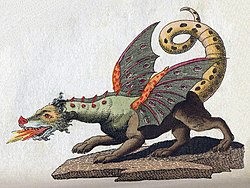
European dragon
Mythical creature in European folklore / From Wikipedia, the free encyclopedia
Dear Wikiwand AI, let's keep it short by simply answering these key questions:
Can you list the top facts and stats about European dragon?
Summarize this article for a 10 year old
The European dragon is a legendary creature in folklore and mythology among the overlapping cultures of Europe.
This article needs additional citations for verification. (July 2020) |
 Illustration of a winged dragon by Friedrich Justin Bertuch, 1806. | |
| Grouping | legendary creature |
|---|---|
| Sub grouping | dragon |
| Similar entities | other dragons |
| Folklore | Medieval folklore |
| Region | Europe and the Mediterranean region |
| Habitat | lairs, caves, castles, mountains |
The Roman poet Virgil in his poem Culex lines 163–201,[1] describing a shepherd battling a big constricting snake, calls it "serpens" and also "draco", showing that in his time the two words probably could mean the same thing.
In and after the early Middle Ages, the European dragon is typically depicted as a large, fire-breathing, scaly, horned, lizard-like creature; the creature also has leathery, bat-like wings, four legs, and a long, muscular prehensile tail. Some depictions show dragons with one or more of: feathered wings, crests, ear frills, fiery manes, ivory spikes running down its spine, and various exotic decorations.
In folktales, dragon's blood often contains unique powers, keeping them alive for longer or giving them poisonous or acidic properties. The typical dragon in Christian culture protects a cavern or castle filled with gold and treasure. An evil dragon is often associated with a great hero who tries to slay it, and a good one is said to give support or wise advice.
Though a winged creature, the dragon is generally to be found in its underground lair, a cave that identifies it as an ancient creature of earth.[citation needed]